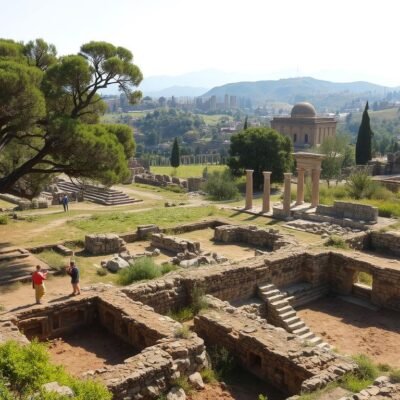Imagine holding a 5,000-year-old artifact that reveals how early humans transformed simple symbols into written language. Recent discoveries in southern Iraq are doing just that, reshaping what we know about humanity’s first steps toward recorded communication.

Archaeologists found striking similarities between cylinder seal carvings (4400–3400 BC) and early proto-cuneiform characters from Uruk, a city that housed 40,000 people at its peak. This connection suggests symbolic systems evolved gradually, not suddenly—like pieces of a puzzle falling into place across centuries.
Technology is accelerating these breakthroughs. Researchers recently used AI tools to reconstruct the long-lost Hymn to Babylon from fragmented clay tablets. What once took decades now takes months, revealing 30 additional manuscripts tied to this Mesopotamian masterpiece.
These findings matter because they show how cities like Uruk became hubs of innovation. Their influence stretched across regions, shaping trade, governance, and culture through standardized symbols. You’re seeing how early marks on clay paved the way for laws, literature, and even modern alphabets.
Key Takeaways
- Cylinder seals and proto-cuneiform share design patterns, showing a 1,000-year evolution of symbols
- AI technology identified 30 lost manuscripts of the Hymn to Babylon in record time
- Uruk’s urban growth directly influenced the development of early written communication
- Written systems emerged from practical needs like trade tracking, not just artistic expression
- These discoveries connect prehistoric symbolism to historic record-keeping methods
Introduction to Ancient Writing Systems
Picture a bustling Mesopotamian market where merchants rolled stone seals on clay to record transactions. This non-literate accounting system tracked textiles and crops across trade routes, laying the groundwork for structured communication. Cylinder seals—carved with intricate symbols—became the earliest “signatures,” pressed into clay to verify ownership.
Understanding the Origins of Writing
Proto-cuneiform emerged as these symbols grew more complex. Archaeologists have decoded just 50% of its 600+ characters, yet even this partial understanding reveals a revolutionary shift. Unlike widespread cylinder seals, proto-cuneiform stayed confined to southern Iraq—a regional solution for managing urban economies.
Early scribes used wedge-shaped marks to document harvests, debts, and laws. These clay tablets became humanity’s first information storage system, predating paper by millennia. What began as farm records evolved into literature, like the Epic of Gilgamesh.
Why This Trend Analysis Matters to You
Studying these systems shows how human cognition adapted to urbanization. You’ll see parallels between ancient inventory lists and modern databases—both organize chaos into usable data. Current archaeology techniques, like 3D scanning fragmented tablets, build directly on these 5,000-year-old innovations.
Every deciphered symbol reshapes our understanding of early governance and trade. When you examine a cylinder seal’s spiral patterns, you’re glimpsing the moment abstract thought became tangible information. That’s history speaking—literally.
Exploring New Insights into Ancient Writing Systems
Consider a stone cylinder rolling across wet clay, leaving behind repeating patterns of jars and woven fabrics. This simple act of sealing goods in 4000 BCE Mesopotamia marked the start of a 1,000-year journey toward formal writing systems. Researchers now see these designs as the DNA of early written communication.

From Seals to Syllables
Professor Silvia Ferrara’s team made a breakthrough by matching specific seal motifs to later cuneiform signs. Their work shows how traders’ jar symbols became standardized characters. Drs. Kelley and Cartolano found cloth transport markers evolved into text elements still recognizable 5,000 years later.
Urban Centers as Innovation Hubs
Babylon’s rise as a global city around 2000 BCE accelerated this transformation. Its markets demanded better record-keeping, pushing symbols toward true writing. You can trace this shift in clay tablets that mix old seal patterns with new accounting symbols.
Modern archaeology benefits tremendously from these discoveries. By studying how practical needs shaped early texts, researchers develop better tools for understanding other undeciphered scripts. It’s like finding the Rosetta Stone for prehistoric communication.
Archaeological Discoveries and Their Historical Context
Think of temples as ancient data centers—sprawling complexes where priests tracked grain stores and textile shipments using carved stone cylinders. During the mid-fourth millennium BC, cylinder seals became essential tools for managing resources across Uruk’s trade network. This accounting system stretched from southwestern Iran to southeastern Turkey, proving early cities needed organized record-keeping.

The Role of Cylinder Seals in Pre-Literate Accounting
You’d roll these palm-sized stones across wet clay to create repeating patterns. Each symbol represented specific products—jars of oil, bundles of wool, or bushels of grain. Temple institutions used them like modern barcodes, verifying shipments between cities without written words. Archaeologists found matching seal designs in distant regions, showing standardized trade practices.
Deciphering Proto-Cuneiform and Its Significance
By 3200 BC, pressed symbols evolved into wedge-shaped marks on clay tablets. These early texts documented debts, harvests, and legal agreements. Researchers recently connected seal motifs to proto-cuneiform signs—like a jar symbol becoming the character for “container.”
This system laid foundations for laws like the Code of Hammurabi. Its “innocent until proven guilty” principle grew from needing fair trade records. What began as simple images on clay became humanity’s first contracts, shaping how we handle information today.
From Clay Tablets to Digital Decipherment
Imagine piecing together a 2,500-year-old poem from shattered clay fragments—a task once requiring decades now takes months thanks to artificial intelligence. This leap forward reshapes how we interact with humanity’s oldest stories.
The Transition from Ancient Systems to AI-Driven Analysis
Assyriologist Enrique Jiménez leads a global effort through the Electronic Babylonian Library Platform, digitizing thousands of cuneiform fragments. His team recently used AI to match 30 scattered pieces of the Hymn to Babylon—a text copied by schoolchildren but lost to modern scholars until now.
You’d marvel at how this 250-line poem describes Babylon’s architecture and spring floods greening fields. Yet most surviving clay tablets exist only as thumb-sized chips. Traditional methods might never have connected these crumbs of history.
Collaborations between the University of Baghdad and Ludwig Maximilian University show technology’s power. Their work on the Sippar Library collection preserves hundreds of tablets while revealing new literary treasures. AI scans for subtle patterns in wedge marks that human eyes might miss.
This isn’t just about reconstructing old texts. It’s rewriting how we study urban life, education, and environmental history across millennia. Every matched fragment adds another verse to humanity’s longest-running story.
Conclusion
The journey from pressed symbols to readable texts shows humanity’s timeless need to share ideas. Professor Silvia Ferrara puts it best: this shift marks “a revolution in cognitive technologies” that turned prehistory into recorded history. You’re witnessing how practical tools like cylinder seals became the building blocks of literature and law.
Modern tech lets you peer deeper into this process than ever before. AI reconstructs fragmented poems while 3D scans reveal hidden patterns in clay. These tools don’t just solve old puzzles—they help scholars decode more symbols daily, adding chapters to our collective story.
What’s truly remarkable? The same drive that created cuneiform shapes how you text and tweet today. Interdisciplinary teams—archaeologists working with coders—are preserving this legacy while uncovering fresh connections across eras. Every discovery reminds us that communication evolves, but its core purpose remains unchanged.
You now hold pieces of a 5,000-year-old conversation. From Mesopotamian markets to digital databases, each innovation builds on what came before. That’s the real lesson here: progress isn’t a sudden leap, but a chain of clever solutions linking past and present.


